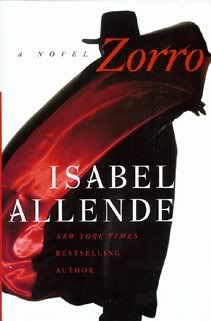Review - Zorro by Isabel Allende

Diego de la Vega leads two very different lives: the aristocratic son of Alejandro de la Vega with an affected air of delicacy who is a bit of a hypochondriac; and the silken, masked heroic crusader of justice, Zorro. Raised near the San Gabriel mission in the late 18th Century, Diego witnessed the scale of mistreatment natives experienced at the hands of Spanish settlers. Acutely aware of his father’s ignorantly complicit role in this, despite allowing an Indian boy (Bernardo) to be raised in his household side by side his son, Diego turns to his mother’s ways. Originally Toypurnia of a local Indian tribe, Alejandro fell in love with her after caring for her wounds and tried to cultivate the Spanish side of her heritage to better ingratiate their marriage into the greater Spanish society. The heavy Spanish dresses and severe hair-dos never suited Toypurnia. As her son grew, she raised him alongside Bernardo, in the ways of her tribe. In this way, both boys grew with an in-depth understanding of both Spanish society and the native ways of those who came before.
Forever marked with the cruelty and injustice exercised by the Spanish, Diego makes a promise to himself: never forget that he, too is part Indian and that injustice to anyone is wrong no matter who they are or where they come from.
Isabel Allende’s Zorro is lyrical and alluring romantic epic. Filled with humor and endearing relationships, Zorro is a spirited adventure of love, justice, and good fun. The narrator is mischievous and as adventurous as her protagonist, tempting the reader with foreshadowing and teasing with narrative interruptions and tangents unrelated to the immediate events of the novel. These interruptions either help to create an air of the circuitous nature of the story as the narrator slowly unspools the threads of Zorro’s life or they’re distractions that serve only to lengthen an already long novel. I prefer the former; Allende’s style of writing supports the nature of those digressions as do the narrator’s character portraits. If you can imagine watching a painting in progress, you can imagine the beauty of Zorro (the novel and character), the optimistic champion of the wronged, a mestizo Robin Hood with a Spanish accent (this, I am only imagining), ears that stick out a bit too much for his comfort, and a fashionable and shiny outfit.
Zorro is split into 5 parts plus an epilogue in which the identity of the narrator is finally revealed to “very inattentive readers” (p. 387) who may not have been able to piece together this mystery on their own. Zorro’s adventures start before he is even born; Allende reconstructs the meeting and eventual relationship of his parents, his childhood, and his journey to Spain and back to Alta California.
For Zorro fans, this isn’t a conglomeration of numerous swashbuckling adventures or hazardous encounters with evil men and women. This version serves more like a prequel to everything we know about Zorro. Think of it as an imagined shaping of the way in which Zorro came to be the caped hero we all know today. This may disappoint readers wanting a tale with a bit more adventure--Allende’s Zorro doesn’t even remotely fall into life-saving circumstances save a handful of times, the last of which, of course, is the most explosive.
There’s also a lot of history in the novel. If you weren’t already familiar with it, Zorro puts into context the ongoing development of California and Mexico under distant Spanish rule when the Mission system is already in place and struggling to stay alive. Spanish and Indian cultures clash dramatically albeit Padre Mendoza is more sympathetic to his acolytes than I would imagine European priests to have been, despite clinging to his religious convictions that the savages must be converted or be doomed to an afterlife in hell. There are native uprisings and rumored talk of independence as exampled by the United States far to the east and the rebellious French across the Atlantic. Also, for those unfamiliar with the terminology or for those who might be bothered with the label: for a very, very long time, Spaniards (and then later, Mexicans as juxtaposed against other people of color, typically Blacks) were considered “white.” Be aware this term is used generously in the context in which it then existed.
Allende’s characters are wonderful. She made the villain into a villain with little to no redeeming qualities which might bother some people. The nasty people in this book really aren’t meant to be sympathized with; Zorro and his friends are clearly supposed to be the “good guys.” This bothered me a little bit, but it’s done in the spirit of the novel which I found excusable considering the other slightly exaggerated recollections of Zorro’s accomplishments.
I do recommend this book as something of a summer read or a long, romantic escape during the winter months. It’s an enjoyable journey, but remember: it’s a journey. Diego de la Vega’s life is epic and it wouldn’t do to begin with anything other than devotion.
Edit: I just realized I reviewed this book without mentioning that it's a translation from Spanish. If you're familiar with translations, you may sympathize with the fact that a lot of times, it's easy to tell when something has been translated. That's not to say the translators do poor jobs, but there is always some subtlety of language that gives it away; Zorro was no exception. I have no plans to read it in Spanish, but if I did (and I can read Spanish, thank you very much), I'm sure it'd read beautifully. Some things will always sound better in their original language. :)
Thanks to phantomminuet for the opportunity to read this book! :)